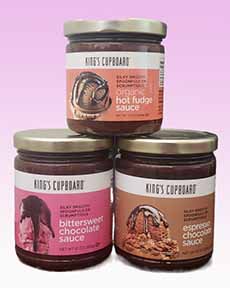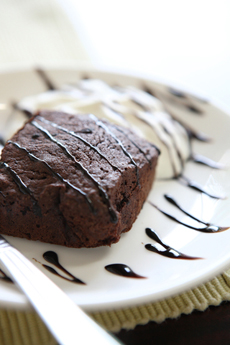FOOD FUN: Pound Cake Sundae Recipe & The History Of Hot Fudge
|
|
When we came across this photo in our Twitter feed, we were reminded of a favorite dessert of our young adulthood: a toasted pound cake sundae with hot fudge or caramel. After our neighborhood Rocking Horse Café closed, our source of an immediate fix was gone. And for some reason, nobody else was selling them then, and even now, to the best of our knowledge. Why not? It’s the easiest “fancy” dessert to make at home—that is, if you buy the ingredients instead of making them all from scratch, as is done by Sticky Walnut restaurant in Chester, England. So there’s no need to get out the cake pans, the ice cream machine, and the double boiler. Sticky Walnut’s dessert, which they call “a lovely little indulgent way to finish off your meal,” reminds us that it doesn’t have to be a big portion. They topped the square of cake with mint chocolate ice cream and dark chocolate sauce. So here’s your shopping list: However, is there something worse than a piece of pound cake drenched with chocolate sauce and melting ice cream? The big question is: Is this cake à la mode, or a pound cake ice cream sundae? Whichever, it’s delicious. Simple chocolate sauces likely existed shortly after cacao came to the Old World in the 16th century. The ground beans were first made into hot chocolate, following the beverage usage for cacao by the Aztecs, Mayas, and other Central Americans. But cooks in Spain and Italy who experimented with the cacao beans no doubt ported the ground beans they used for beverages into sauces, both sweet and savory. We know that in 1674 there were chocolate puddings and pastilles* [source]. Pharmacists first created chocolate syrups with cocoa powder and sugar in the 19th century. In 1828 that a chemist in the Netherlands, Coenrad J. Van Houten, took out a patent for a process to manufacture a type of chocolate with a much-reduced fat content. This chocolate, which was made in block or cake form, could be easily reduced to a fine powder—i.e., cocoa powder. Cocoa powder was one step away from chocolate syrup: Just mix the powder with sugar and water. The popularity of pharmacist-made chocolate syrup exploded in the late 19th century [source]. Chocolate sauce vs. chocolate syrup: A syrup is a flavored sugar solution. Real hot fudge sauce came in the late-19th century. The first hot fudge sauces likely resulted from early fudge-making failures, when the ingredients that wouldn’t solidify into fudge were eaten up with a spoon (the history of fudge). By the 20th century, people began deliberately undercooking fudge so they could serve it warm over ice cream, creating banana splits, hot fudge sundaes, and other soda fountain treats. The hot fudge sundae was one of many ice cream sodas, floats, and sundaes that were created during Prohibition, when the bars were closed and many people hung out at the soda shop (often the soda counter of the local drugstore). Fudge sauce is different from ordinary chocolate sauce, which is made from cocoa powder, sugar, salt, and vanilla. Fudge sauce adds cream and butter. It’s made like those early fudge failures: It’s fudge that never sets. Cream or milk, sugar, and butter are slowly boiled down until slightly thickened and light caramel-colored. The boiling-down process not only gives the sauce a thicker texture, but also contributes to the “fudgy” taste of the sauce. Today, hot fudge sauce recipes almost always include corn syrup, which contains anti-setting properties that prevent fudge from turning into thick fudge candy regardless of the cooking time [source]. |
|
|
________________ *There are different definitions for “pastille.” Today, in the U.K., they refer to chewy gel candies (like Rountree’s). On the Continent, they are small hard candies used for lozenges, flavored with fruit or herbs. Still other companies, like Droste, sell tubes of small, flat, round chocolate pieces they call pastilles. The original pastilles were the latter, hard chocolate. CHECK OUT WHAT’S HAPPENING ON OUR HOME PAGE, THENIBBLE.COM. |
||







